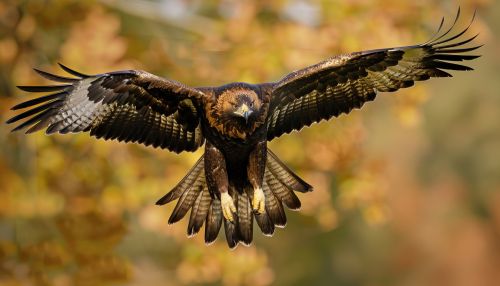Golden Eagle
Taxonomy and Description
The Golden Eagle (Aquila chrysaetos) is one of the most well-known birds of prey in the Northern Hemisphere. It is the most widely distributed species of eagle and belongs to the family Accipitridae. These birds are dark brown, with lighter golden-brown plumage on their napes. Immature eagles of this species typically have white on the tail and often have white markings on the wings.


Distribution and Habitat
Golden Eagles are found throughout much of the Northern Hemisphere. They can be found in Eurasia, North America, and parts of North Africa. They inhabit a wide range of habitats, including tundra, shrublands, grasslands, forests, agricultural fields, and even deserts. They are most commonly found in mountainous regions.
Diet and Hunting
Golden Eagles are carnivorous and are known for their exceptional hunting skills. They primarily feed on small to medium-sized mammals such as rabbits, hares, ground squirrels, and prairie dogs. They are also known to prey on larger mammals such as foxes, young deer, and livestock. They have even been known to attack and kill fully grown adult deer.
Reproduction and Lifespan
Golden Eagles are monogamous and mate for life. They build large nests in high places (like cliffs and trees) to which they may return for several breeding years. Females lay up to four eggs, and both parents incubate them for 40 to 45 days. The lifespan of a Golden Eagle in the wild can be up to 30 years, but the average lifespan is closer to 20 years.
Conservation Status
The Golden Eagle is listed as Least Concern by the IUCN. However, they are threatened by habitat loss, persecution, and collisions with power lines. Conservation efforts are focused on habitat preservation and reducing human-wildlife conflict.
Cultural Significance
Golden Eagles have been regarded with reverence in various cultures throughout history. They have been used in falconry for thousands of years, and their feathers are considered sacred by some Native American tribes. In ancient Rome, the Golden Eagle was the symbol of the Roman legions, and in modern times, it is the national bird of several countries including Mexico, Germany, and Austria.
